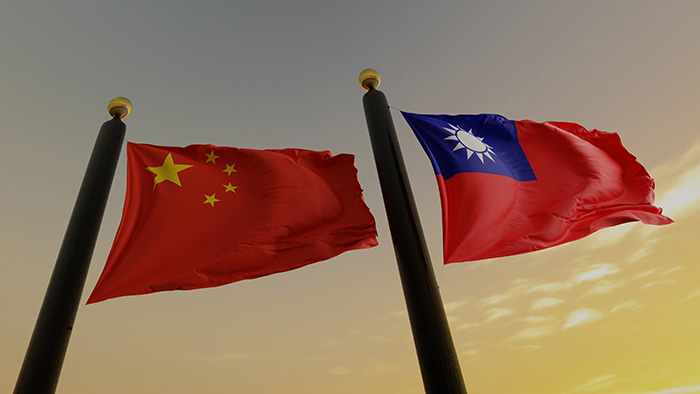Interviews / Asia-Pacific
15 October 2024
Chinese Military Maneuvers Around Taiwan: A Warning or the Start of a Conflict?

Incidents between China and Taiwan have multiplied in recent years. The visit of U.S. House Speaker Nancy Pelosi to Taipei in August 2022 notably triggered a strong Chinese response, culminating in military maneuvers within Taiwan’s territorial space. The recent movements of the Chinese military, detected in the area this Monday, are unprecedented, with over a hundred fighter jets and several warships involved. How can this rise in tensions in the South China Sea be explained? What could be the consequences? How are Taiwan’s allies reacting? Insights from Barthélémy Courmont, research director at IRIS and head of the Asia-Pacific Program.
On Monday, October 14, China deployed a large number of aircraft and warships around Taiwan. How can this escalation in tensions between Taipei and Beijing be explained, with some suggesting an intent to blockade the island?
On the occasion of Taiwan’s National Day, President Lai Ching-te, elected last January but who took office in May, delivered a speech in which he reiterated that neither side of the Taiwan Strait should be subordinated to the other. Such a statement is not provocative, as the Taiwanese president is merely reaffirming, as his predecessors have, the foundations of Taiwan’s territorial and political sovereignty. However, Beijing immediately condemned this as a pro-independence stance, justifying the deployment of significant military forces to “condemn” such a position. On the Taiwanese side, the Ministry of Defense responded by announcing the deployment of forces to defend Taiwan in the event of aggression. In practice, China launched an operation similar to the one in August 2022, the largest up to that point, aimed at demonstrating its ability to encircle Taiwan, before officially declaring the operation completed. More than 150 Chinese aircraft and 14 ships were detected in one day, setting a new record. This was a way for Beijing to send a strong message and refine its encirclement capabilities.
What has been the reaction of other powers in the Indo-Pacific region, starting with the United States, following this event?
In the midst of an electoral campaign, Japan quickly reacted to China’s maneuvers, expressing strong concerns and sending several fighter jets near the area. Also in the middle of an electoral campaign, Washington is worried about an escalation, and Secretary of State Antony Blinken warned Beijing against any provocation towards Taiwan. The issue for both countries lies in how to respond to these provocations. Despite its increased defense ambitions, it is hard to imagine Japan engaging in a conflict with China over Taiwan. On the American side, regardless of the profile of the future occupant of the White House, there is no intention to get involved in a new conflict, even at a distance. The Taiwanese know that when facing China, they must primarily rely on themselves, which leads them to believe that by the time an offensive is launched, it will be too late to respond. Therefore, they are seeking another path, based on deterrence, encouraging Beijing to reconsider its ambitions by analyzing the disastrous consequences of such a war. As Taiwan’s main arms supplier, the United States is watching this new development with the concern of a power that no longer has a direct role, as was the case, for example, in 1996 during the first major crisis in the Taiwan Strait, when Washington deployed several warships.
Are we on the brink of an open conflict, and with which powers involved? Or are we facing yet another round of Chinese agitation with no follow-up effects?
The risks of armed confrontation remain high in the Taiwan Strait. These risks are today heightened by Beijing’s determination and the considerable military resources at China’s disposal, which, through this new display of strength, have provided further evidence—if more were needed—of its ability to encircle Taiwan. However, this episode closely resembles that of August 2022, following the visit to Taipei of U.S. House Speaker Nancy Pelosi. For Beijing, this is about seizing every opportunity to remind its neighbor that China is now in a position of strength. But this does not mean that a direct confrontation is inevitable, and Beijing’s leverage is much greater in other areas, such as diplomacy, the economy, or cognitive warfare. A war would be an ultimate resort, and China excels at flirting with the red line without crossing it. This should not, however, reassure the Taiwanese, who understand that their neighbor keeps a close watch on them, and that even the smallest actions are immediately used as a pretext for growing pressures.

